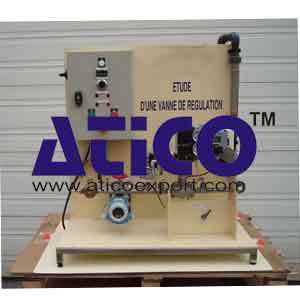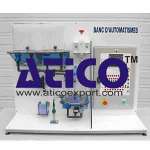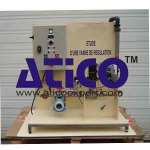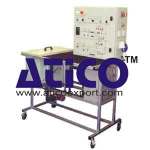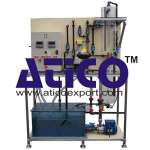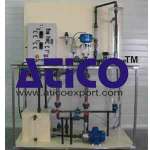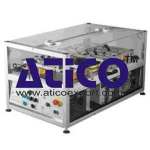Control Valve Study Bench
Teaching Objectives of
Control Valve Study Bench
- Determination of the experimental KVS of the valve with and without positioner.
- Drawing and study of the curves.
- Intrinsic features of the valve.
- Qv = f(control) at constant head loss.
Feature of the installed valve :
- Qv and ΔP = f (control).
- Function of the positioner and phenomenon of hysteresis.
Functioning
- A pneumatic servomotor valve is supplied by the water network via a needle control valve. The flow is measured by a rotameter. A regulator allows to adjust the pressure of the network.
- The difference of pressure between the upstream and downstream of the control valve is measured with the help of a differential pressure transmitter with local display.
- The influence of the positioner on the answer of the valve is determined with the help of a current generator (4/20 mA) allowing the control of the control valve servomotor via an I/P converter (0,2 to 1 bar) or via a pneumatic electro-positioner.
- The device is mounted on a welded stainless steel frame, equipped of 4 adjustable feet.
Technical specifiations
- A regulator 0-3 bar of the water supply circuit with manometer.
- A needle flow adjusting valve made of stainless steel.
- A pneumatic needle control valve with variable Cv made of stainless steel.
- An electro-positioner.
- A regulator, with air oil separator and manometer.
- A differential pressure transmitter with local display and bleeding manifold.
- A rotameter (scale 60 to 600 l/h).
- An electrical cabinet, IP 55, including .
- A padlocked main switch.
- A ON light.
- An emergency stop button with key.
- A current generator (4/20 mA) with potentiometer and indicator.
- Control signal output by safety plugs.
- Technical manual in English
Essential requirements
- Power supply: 230 V, 50 Hz, 250 W
- Compressed air: 6 bar, 3 Nm3/h.
- Water: network clean water 3 bar, 20 °C, 1000 l/h.
Dimensions
- 850 x 425 x 940 mm

